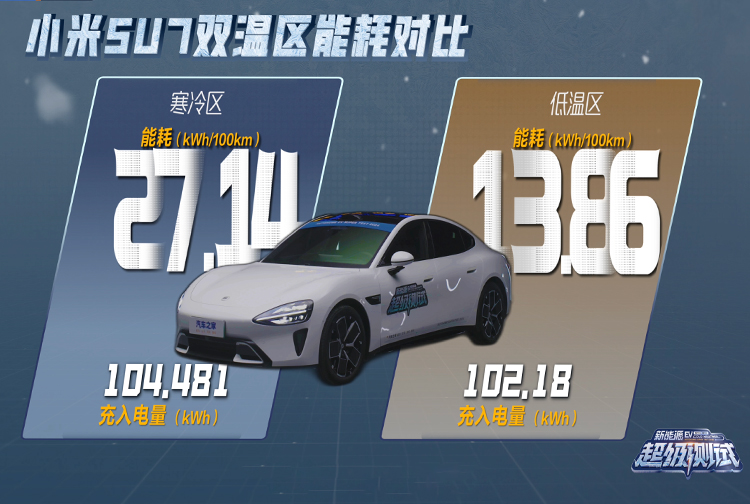2024 Auto Home New Energy Super Test, this issue will reveal the final results of the range, energy consumption and charging of Xiaomi SU7 (2024 800km 4WD Ultra Long Range High-end Smart Driving Max Edition) in the dual-temperature zone (low-temperature zone of 5~15℃, cold zone of -20~-25℃) test, which has a range of 810 kilometers, thanks to the 19-inch low-wind-resistance wheels that have been optionally fitted to the test vehicle.

The test environment covers two major temperature zones in the winter of new energy models, three dimensions, to address the needs of real users, and at the same time, we also make a comprehensive assessment of air conditioning warming and vehicle product stability. To bring you a useful winter test.

Cold zone test environment: -25℃~~-20℃
Test route: Hulunbeier Chenbalhu Banner - Cold Pole Genhe (round trip)
Test method: 50% high speed condition + 50% low speed condition
In the cold zone, Xiaomi SU7 departed with a full charge and traveled a total of 385 kilometers, reaching a rate of 47.5%, and ranked first in the group in terms of measured range in the cold zone.
.jpg)
Charging session at the end of the test, we use cold car cold charging charging method, cold zone 0-100% charging time 67 minutes, 30-80% charging time 25 minutes, at 30% to reach the maximum power of 119kw and continue to 80%, the entire charging process of the maximum power is very stable, and effectively improve the charging speed.

In terms of energy consumption, the Xiaomi SU7 consumes 27.14kWh/100km in the cold zone, based on the charge and the actual range.
In the air conditioning comfort test, Xiaomi SU7 performs better both in the range test and the cold car rise test. First, in the range test, with the air conditioning set at 23°C auto, the interior can be maintained at a stable level of between 21-22°C, and only after the vehicle's SOC is lower than 3%, the temperature inside the car starts to drop, and the overall performance is more stable. And in the standard test of air conditioning, Xiaomi SU7 after 2 hours of outdoor static, open the air conditioning, turn on the highest temperature, maximum airflow, 20 minutes after the temperature rise to +19.7 ℃, an increase of 32.2 ℃.
.jpg)
Low Temperature Zone Test Environment: 5~~15°C
Test method: 50% high speed working condition + 50% low speed working condition
In the low-temperature zone, Xiaomi SU7 set out on a full charge and travelled a total of 737 kilometres, reaching 91%, which is 352 kilometres more than the cold zone.

In the charging session at the end of the test, we used cold charging with a cold car. 0-100% charging time in the low-temperature zone was 64 minutes, and 30-80% charging time was 2 minutes slower than the cold zone, at 27 minutes. The maximum charging power of 116kw was slightly lower than that in the cold zone, which is the reason for the slower charging time in the low-temperature zone of 30-80%.
.jpg)
In terms of energy consumption, the Xiaomi SU7 consumes 13.86kWh/100km in the low-temperature zone, based on the charge and the actual range.
In this new energy super test, Xiaomi SU7 harvested 1 range badge, 1 charging badge, 1 energy consumption badge, 1 comfort badge, and 1 reliability badge, totalling 5 badges.
Conclusion: The above is the overall performance of millet SU7 in this new energy super test, as a brand new brand new models, the first time to participate in such a test, can come up with such results is indeed rare.



.jpg)

.jpg)

.jpg)
.jpg)



.jpg)
.jpg)
.jpg)
.jpg)



